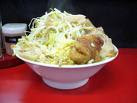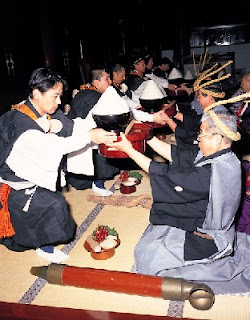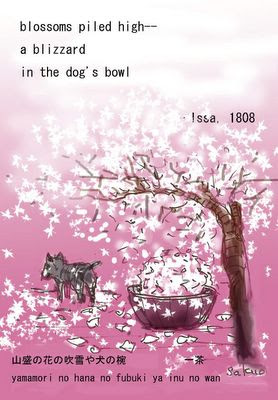[ . BACK to WORLDKIGO TOP . ]
. Legends from Nikko 日光 .
:::::::::::::::::::::::::::::::::::::::::::::::::::::::::::::::::::::::::::::::::::::::::::::::::::
Large food portions (yamamori)
***** Location: Japan
***** Season: Non-seasonal Topic
***** Category: Humanity
*****************************
Explanation


Food is piled up on your plate "like a mountain", yamamori 山盛り.
Large portions are also called "oomori" 大盛り.

:::::::::::::::::::::::::::::::::::::::::::::::::::::::::::::::::::::::::::::::::::::::::::::::::::::

There is a ceremony in Nikko where the participants receive large bowls of rice.
Nikko Gohanshiki (Nikkoo Goohan-Shiki 日光強飯式 )
Nikko Gohan Shiki
Rinnoo-JI Goohanshiki 輪王寺強飯式(りんのうじごうはんしき)
Nikkoozeme 日光責(にっこうぜめ)
tengu no goohan 天狗の強飯(てんぐのごうはん)
large rice portion of the tengu goblin
kigo for late spring
Every year on the second of April, this ceremony is held at the "Hall of the three Buddhas" at the temple Rinno-Ji in the town of Nikko. It is a native form of mountain worship.
日光市の輪王寺三仏堂
"Men of the Year" (born in the year with the same Asian zodiac animal) receive a large portion of rice and pray for the safety of home and family, prosperous business and the carrying of on his male family line.
They really have to force the rice down, meshi o shiiru 飯を強いる.
You can see the rice piled up "like a mountain", which he holds over his head before eating.
A priest in the cloths of a mountain ascetic carries the bowl in front of the receiver 頂戴人 and shouts: "You have to eat all this now!"
One bowl contains 5,4 kilograms (一升五合) of rice.
When they eat it all, they will have good luck for the coming year.

The three Buddhas of the Hall are Senju Kannon, Amida Nyorai and Bato Kannon with a horsehead.
This ceremony goes back to Saint Shodo Shonin (Shoodoo Shoonin 勝道上人)(735 - 817), who started the mountain worship in Nikko, connecting the Shinto and Budshist religion. The took the food that the ascetics had offered to the deities, carried it down to the poor farmers and gave it to them to eat.
Later it evolved as a ceremony to partake of the powers of the three Buddhas and the three TEN deities of Daikokuten, Benten and Bishamonten, when normal people started eating the food offerings.
During the Edo period, after Tokugawa Ieyasu was enshrined in Nikko, many daimyo or their representatives came to Nikko to worship and partake of the food offerings 強飯頂戴人(ちょうだいにん choodainin)for the wellbeing of their local domain.
When you can participate in this ceremony, you have the following
goriyaku good fortunes
the seven misfortunes will leave immediately
shishinan sokumetsu 七難即滅
the seven types of good luck will come immediately
七福即生 shichifuku sokusei
The ceremony has various parts.
santen googyooku 三天合行供
saidoo taigomaku 採灯大護摩供
secret rituals of Nikko, 20 yamabushi blowing conches enter the hall. Then all the doors are closed and only one candle kept in the dark.
From the back you hear hte voice of "santen googyooku" reading the sutra and a goma fire ceremony is held.
next comes light in the hall and then
goohan choodai no gi 強飯頂戴の儀
receiving the large rice portions
They receive the following items
「御神酒」「祈願文」「強飯」「菜膳」「金甲」「供養」
Finally the high mountain ascet, sendatsu, makes a roaring speach.
大先達口上 daisendatsu koojoo
Once the ceremony inside is finished, all go out for
がらまき garamaki
and with respect to the Buddhist teaching "Not to keep things for yourself, share things with others" they throw lucky charms and toys to the crowd waiting outside.
During the Edo period, you had to be a daimyo of at least juumangoku 十万石 riches to partake, but now anyone can apply.
The participants get a talisman in form of a rice ladle, to ladle good luck to their family. They also get some "lucky rice" (fukumai 福米) to take home and share with their family members.
. Soomen Jizoo そうめん地蔵 Somen Noodles Jizo .
A legend that tells the origin of the Nikko Gohanshiki.
Shoodoo Shoonin 勝道上人 Priest Saint Shodo Shonin

- quote -
There are many spiritual spots in Nikko where Shodo Shonin (Saint Shodo), stepped in for the first time in the 9th Century and where the Nikko Toshogu Shrine was built on the basis of Onmyodo (yin-yang philosophy), in the 17th Century.
-- There is a legend that when Shodo Shonin (Saint Shodo), who firstly served as the head priest of Nikko, was not able to cross the Daiyagawa River and asked for help to deities and Buddhas, two snakes appeared and transformed to this bridge Shinkyo Bridge. The bridge belongs to the Nikko Futarasan-jinja Shrine.
-- Tachikikannon Tachikiri Kannon is an associated shrine of the World-Heritage Nikkosan Rinno-Ji Temple founded in 784 by Shodo Shonin (Saint Shodo),, who firstly served as the head priest of Nikko. The Kannon (Boddhisattva), statue that is said to be sculptured by Shodo Shonin himself is still spreading its root to the ground. In addition, the shrine houses various characteristic statues of Buddha, such as Hashiri Daikokuten.
-- Kaisandou, Kaisando, Nikkosan Rinno-Ji Temple
Kaisandou is the mausoleum of Shodo Shonin (Saint Shodo),, who firstly served as the head priest of Nikko. The mausoleum has a vermilion-lacquered, multistoried and square-styled hall that enshrines the wooden honzon (principal image of Buddha), Jizo Bosatsu (Jizo Bodhisattva),, which is said to be produced in the 14th or 15 century. This place is also known as a location that people can feel mystical energy of the god to protect the Nikko mountains.
-- Nikko Futarasan-Jinja Shrine
In 766, Shodo Shonin (Saint Shodo), stepped into the mountains in Nikko.
- source : nikko-travel.jp/english-
. hashiri Daikoku 走り大黒 / 波之利大黒天 running Daikoku .
- - - - - Saint Shodo Shonin and the Tengu of Nikko - - - - -
. Tengu, sugi 天狗と杉と伝説
Legends about Tengu and Cedar trees .
. Nikko Hotokeiwa 日光仏岩 Hotoke Iwa "Buddha rock" in Nikko .
Shodo was cremated in the valley of crags, which was located near the Kaizan-do hall of the founder.
:::::::::::::::::::::::::::::::::::::::::::::::::::::::::::::::::::::::::::::::::::::::::::::::::::::
Kodomo Gohanshiki for Children
Shrine Ikioka Jinja 生岡(いきおか)神社
Takes place in November.
Local boys of the elementary and junior high school wear costumes of mountain ascetics (yamabushi) and strong porters (goriki). They enter the hall when the trumpet shells are blown and drums beaten. They perform eating a large amount of rice. On the rice grated radish is also placed.
"Eat your 75 portions of rice!" shouts the mountain ascet.
"コリャ、中宮祠の木辛皮、寂光の青山椒、お花畑の唐辛子、生岡神社の生大根」「諸所の名物よせてのご馳走、七十五杯ヅカヅカおっとりあげてのめそう!"
"and do not leave one grain back"
The ascetic then holds a piece of radish with salt in front of the mouth of the participants and they try to catch and eat it.
Finally the children get a toy stick horse (harukoma 春駒) and ride three times around, with the main preist riding on a stick horse too.
*****************************
Worldwide use
*****************************
Things found on the way

『山盛りの十七文字』
Heaping 17 sylables into a mountain of meaning !
Teaching haiku at a school in Mie prefecture
© www.pref.mie.jp
*****************************
HAIKU
山盛の花の吹雪や犬の椀
yamamori no hana no fubuki ya inu no wan

blossoms piled high--
a blizzard in the dog's bowl
Issa, 1808
Tr. David Lanoue, Haiga: Nakamura Sakuo
cherry blossoms
blown in the dog's bowl -
a real heap full
Tr. Gabi Greve
This hokku has the cut marker YA at the end of line 2.
..........................................................................
. WKD : Kobayashi Issa 小林一茶 in Edo .
yamamori no hana no fubuki ya inu no wan
blizzard --
cherry petals fill
the dog's bowl
Tr. Chris Drake
This hokku was written on 3/27 (April 22) in 1808, so the cherry tree(s) must be late-blooming varieties. At the time Issa was living in Edo. Most of the falling petals are eventually blown away by the wind, but those that fall in the dog's bowl remain and pile up, a single collection of blossoms that suggests the virtual petal drifts that could have covered the whole area. The heaping portion of petals rises higher and higher until, presumably, it overflows the dog's bowl, unless, of course, the dog is eating the petals.
The yamamori (山盛) in Issa's hokku is a common word that has nothing to do with a forest guard or ranger (山守) and cannot signify one. The two are completely separate words that happen by chance to be homophonous. The difference between the characters is due to the Chinese and Japanese languages and is not Issa's special distinction. The word used by Issa, as Gabi correctly states, means only a goodly pile or mound and does not contain any kind of reference to forest guards/rangers.
Chris Drake
:::::::::::::::::::::::::::::::::::::::::::::::::::::::::::::::::::::::::::::::::::::::::::::::::::::
婿星も見よ山盛の稲の花
muko-boshi mo miyo yamamori no ine no hana
O Bridegroom Star
look! piles
of blossoming rice
Issa
Tr. David Lanoue
*****************************
Related words
***** mountain ragner, forest warden,
yamamori 山守
yama o mamoru, to protect a mountain
topic for haiku
In some areas of modern Japan with a lot of forestry area, the Yamamori system where local persons called Yamamori are entrusted with the care of an absentee owner's forest in response to consignment from the end of the Edo period; the Yamamori performs the forest management.
山守や春の行方を箒して
yamamori ya haru no yukigata wo hôki shite
forest ranger--
he sweeps away spring
with a broom
山守の箒の先を行春ぞ
yamamori no hôki no saki wo yuku haru zo
from the end
of the forest ranger's broom...
spring departs
Issa
Tr. David Lanoue
:::::::::::::::::::::::::::::::::::::::::::::::::::::::::::::::::::::::::::::::::::::::::::::::::::::
***** Food from Japan (washoku) Sweets from Japan (wagashi)
***** . Tengupedia - 天狗ペディア - Tengu ABC-List .
WKD - Saijiki for Festivals and Ceremonies
[ . BACK to DARUMA MUSEUM TOP . ]
[ . BACK to WORLDKIGO . TOP . ]
:::::::::::::::::::::::::::::::::::::::::::::::::::::::::::::::::::::::::::::::::::::::::::::::::::::
8/05/2007
Large portions (yamamori)
Subscribe to:
Post Comments (Atom)







2 comments:
あ~面白かった。
楽しさが山盛りだ。
ガビさん、ありがとう。
sakuo
Nikko 日光 と伝説 Legends about Nikko
二荒山 Mount Futarasan
男体山 Mount Nantaisan
.
hashiri Daikoku 走り大黒 / 波之利大黒天 running Daikoku Ten / walking Daikoku
.
https://heianperiodjapan.blogspot.com/2018/12/nikko-tochigi-legends.html
.
Post a Comment